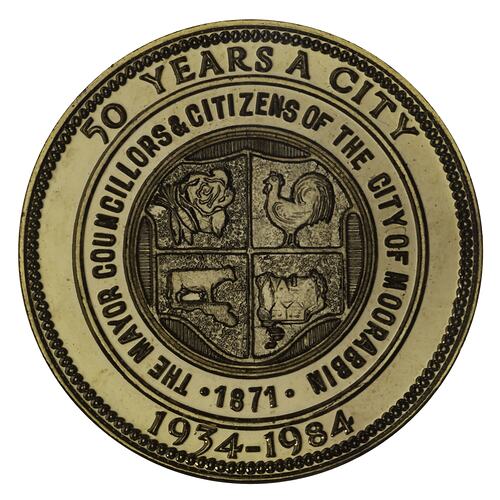Moorabbin is a residential and industrial suburb, 16 kilometres south-east of Melbourne on the Nepean Highway, near Port Phillip Bay. It was reputedly a place where Aboriginal mothers and children stayed while male tribesmen went further afield, and its name is thought to have been derived from an Aboriginal word meaning mother's milk. There was a series of springs or soaks through the area.
The first settlers in the Moorabbin area, brothers John and Richard King, arrived in 1846, possibly from the Westernport area. By the 1850s the pastoral runs in Moorabbin were being subdivided, and Moorabbin grew as a farming and market garden area. The district relied on the Brighton township and smaller villages at Sandringham and at Cheltenham. In 1854 the Wesleyan church opened a primary school which continued until 1872, when it was replaced by a State primary school. In 1862 Moorabbin (which included Sandringham, Mentone and Mordialloc) was made a Road Board District. On 27 January 1871 it was made a shire.
In 1881 the railway line was extended from Caulfield to Frankston, and a station was opened at Moorabbin. The township of Moorabbin, known as South Brighton until 1909, remained small, with the Plough and Harrow Hotel as its main building. In 1917 Sandringham borough was formed by severance from Moorabbin shire and in 1920 Mentone and Mordialloc were also severed. In the remaining Moorabbin shire the Moorabbin township was still small (1,770 persons), but the shire grew in population during the 1930s. On 10 October 1934 it was proclaimed a city. It existed as a separate municipality until 1995.
Moorabbin became increasingly industrial, with flat sandy soil providing large and stable sites for factories. Moorabbin East became mainly industrial, with factories and warehouses. The Phillip Morris cigarette manufacturing plant and several other large plants were opened in Chesterville Road. Coca Cola Bottlers was located nearby.
The Moorabbin district's flat ground also attracted flying activities. The first Aerial Derby was held at the Epsom racecourse, Mordialloc, in 1920. In December 1949, metropolitan Melbourne gained a second general airport when the Moorabbin (Harry Hawker) Airport opened, and during the 1960s was the busiest airport in Australia for small and medium planes.
In the early post-war years Moorabbin city's population more than doubled to 65,000 persons. By 1966 it exceeded 100,000. The area between Bentleigh and Moorabbin was filled with residential subdivisions. During the 1950s to 1970s Moorabbin city was metropolitan Melbourne's burgeoning 'sand belt' residential area. The Council opened a new town hall and offices in 1963.
Between 1950 and 1963 three more primary schools were opened in Moorabbin, of which one had closed by 1995. A technical school was opened in 1954 and a high school in 1963.
When local government boundaries were changed in 1994 about half of Moorabbin city was united with Glen Eira city and about half with Kingston city.
On 15 December, 1994 the City of Chelsea, parts of the Cities of Mordialloc, Moorabbin, Springvale and Oakleigh were amalgamated to create the City of Kingston by Order of the Governor in Council. On the same day Glen Eira City Council was formed from the City of Caulfield and the remaining part of the City of Moorabbin.
In 1985 the City of Moorabbin issued a medal [NU 20677] to commemorate the Sesquicentenary of Victoria.
References:
Australian Places website, Monash University http://arts.monash.edu/ncas/multimedia/gazetteer/list/moorabbin.html
More Information
-
Keywords
-
Localities
-
Authors
-
Article types


















